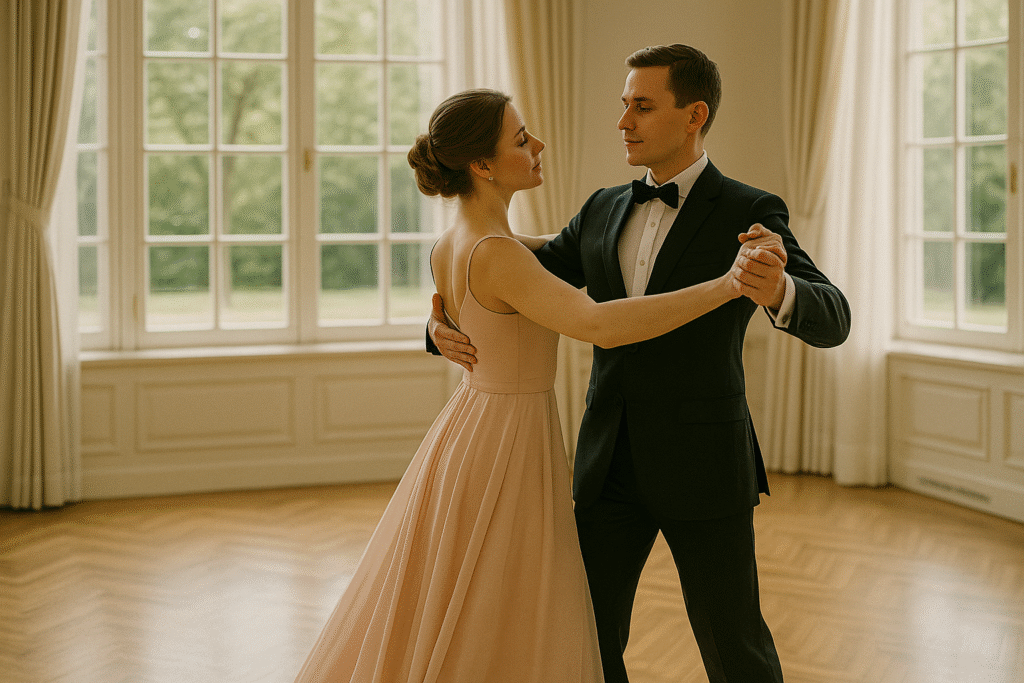
When one imagines the elegance of ballroom dancing, the Waltz often springs to mind. With its flowing movements, sweeping turns, and timeless charm, the Waltz is a cornerstone of ballroom tradition and one of the most romantic partner dances ever created. Rooted in history yet still thriving on modern dance floors, the Waltz remains a favorite for weddings, competitions, and social gatherings around the world.
Whether you’re just starting your dance journey or deepening your knowledge of ballroom styles, this guide will take you into the heart of the Waltz—its history, technique, variations, and enduring appeal.
The Origins of the Waltz
The Waltz originated in the late 18th century in Austria and southern Germany. It evolved from folk dances like the Ländler, a rustic, turning partner dance popular among peasants. The word waltz comes from the German “walzen,” meaning “to turn” or “to glide.”
Initially considered scandalous due to the close embrace of partners (unheard of at the time), the Waltz gained popularity in Viennese ballrooms and quickly spread across Europe. By the 19th century, it had become a staple of formal events and high society, cementing its place as one of the most iconic and influential dances in the Western world.
Musical Structure and Timing
Waltz music is written in 3/4 time, which means each measure has three beats—with the first beat being the strongest. This rhythm creates the characteristic “ONE-two-three, ONE-two-three” pattern that dancers glide to.
The music is typically romantic, flowing, and melodic, making it ideal for storytelling through dance. Popular Waltz tempos include:
- Slow Waltz (International Standard): ~28-30 beats per minute
- Viennese Waltz: ~58-60 beats per minute
The slow tempo of the traditional Waltz allows for graceful movement, deep rise and fall, and fluid rotation—all hallmarks of the style.
Waltz Technique and Styling
The Waltz is known for its smooth, gliding steps and seamless turns. Dancers appear to float effortlessly across the floor, creating a dreamy, continuous motion.
Key Characteristics:
- Rise and Fall: One of the Waltz’s most distinctive features. Dancers rise on the toes during beats two and three, then lower on beat one of the next measure.
- Sway: A gentle tilting of the upper body that enhances the elegance and dynamics of the movement.
- Rotation: Waltz often involves turning in both natural (right) and reverse (left) directions, maintaining balance and spatial awareness.
Basic Step Pattern (for Leaders):
- Step forward with the left foot (beat 1)
- Step to the right with the right foot (beat 2)
- Close left foot to right foot (beat 3)
Followers perform the reverse, starting backward with the right foot. Together, these steps form the box step, the foundation of beginner Waltz technique.
Posture and Frame:
Good posture is essential—shoulders down, back straight, and neck long. The connection between partners should be strong but flexible, with an elegant ballroom frame that allows fluid motion and precise communication.
Variations of the Waltz
Over time, several distinct forms of the Waltz have emerged, each with its own flair and cultural influences:
1. International Standard Waltz
- Used in competitive ballroom dance.
- Focuses on strict technique, closed hold, and graceful floor movement.
- Emphasizes rise and fall and intricate footwork.
2. American Style Waltz
- Offers more freedom, allowing open holds, underarm turns, and creative choreography.
- Popular in social and wedding dance settings.
3. Viennese Waltz
- Faster, more traditional version.
- Features continuous turns and graceful spinning.
- Known for its lightness and high energy.
Each variation brings something special to the dance floor, allowing dancers to adapt their style based on the setting and music.
Why Learn the Waltz?
Learning to Waltz is a rewarding experience that offers both personal and social benefits:
- Romance & Connection: Few dances express love and partnership as beautifully as the Waltz.
- Confidence: Mastering the Waltz builds self-assurance, poise, and presentation.
- Fitness: Waltzing improves balance, coordination, and leg strength.
- Stress Relief: The music and flowing movement can be calming and meditative.
- Social Skills: A great icebreaker and a wonderful way to meet people at social events or dance classes.
The Waltz is also a go-to choice for wedding dances, making it a practical skill for couples preparing for their big day.
Common Waltz Figures and Moves
As dancers progress, they learn a variety of Waltz figures that add depth and excitement to their routines:
- Natural Turn
- Reverse Turn
- Closed Change
- Whisk and Chassé
- Hesitation Step
- Outside Change
- Drag Hesitation
- Contra Check
These steps are combined with elegant arm styling, expressive upper body movement, and musical interpretation to create beautiful performances that captivate audiences and judges alike.
The Waltz in Popular Culture
From lavish ballroom scenes in classic films to contemporary television shows like Dancing with the Stars, the Waltz has remained a symbol of grace and elegance in popular culture.
Famous examples include:
- “The Blue Danube” by Johann Strauss II – arguably the most iconic Waltz ever composed.
- Cinderella’s ballroom scene – an animated Waltz moment that captured hearts worldwide.
- Bridal Waltz – a tradition in many weddings where the couple opens the dance floor with a Waltz.
These cultural moments continue to reinforce the Waltz’s reputation as the dance of fairy tales and timeless beauty.
The Waltz isn’t just a dance—it’s an experience of grace, rhythm, and connection. Whether you’re gliding across the floor in a dazzling ballroom or taking your first box step in a dance class, the Waltz invites you into a world of poise, passion, and enduring charm.
